Abstract
Within the frame of an in-depth study of the corpus of about 560 western Greek transport amphorae (6th–5th century BC) yielded from excavations at the necropolis of the Dorian-Chalcidian colony of Himera in North-western Sicily, one of the most interesting issues consists in the determination of their provenance. Based on archaeological considerations, nearly 100 items have been attributed to southern Campania, specifically to Poseidonia and Elea. The present paper proposes a detailed combined archaeological-archaeometric investigation of 16 samples discovered at Himera and one at Jerba (Tunisia), of presumed Campanian provenance, compared with 4 local reference samples from Poseidonia and 6 samples of western Greek amphorae found at Pithekoussai and Elea, attributed to Poseidonia by previous archaeometric analysis. All samples have been submitted to a macroscopic fabric examination according to the standard methods of FACEM (Fabrics of the Central Mediterranean) and to petrographic investigation (polarised light microscopy) and digital image analyses of microstructures. Our study points to a Campanian provenance of the investigated amphorae and their distinction in a large group from Poseidonia and a small group from Elea. The identification of a numerous assemblage of 5th century BC Poseidonian transport vessels at Himera substantially underlines an earlier hypothesis about its ‘Campanian connection’ and allows for the reconstruction of an important Tyrrhenian commercial axis.
1. Introduction and Archaeological Background
The intensive, archaeological excavations of the eastern and western necropolis of Himera (in detail, see Section 2.1) have yielded c. 3100 transport amphorae reused in enchytrismos burials. Among this exceptionally large ensemble, c. 560 western Greek amphorae form the largest selection of this class ever unearthed in the central Mediterranean area. The term ‘western Greek’ indicates transport vessels developed by numerous Greek apoikiai of Magna Graecia, Sicily, the Ionian-Adriatic area and southern France. The earliest items of this family, dating to the first half of the 6th century BC, derive from a common archetype—Sourisseau’s form 1α (Figure A1a)—produced along the southern and eastern shores of Calabria, namely at Sibari, as well as in the region of Corkyra/Bouthrotum [1,2,3,4,5,6].
During the latter part of the 6th and early 5th century BC and contemporaneously to the latest examples of this shape, several colonies launch the production of Sourisseau’s forms 2–3 (Figure A1b,c), which form a sort of morphological koiné conjoining many of the Greek colonies. For still-unknown reasons, from the second quarter of the 5th century BC onwards at the latest, the typological development of the western Greek amphorae shows at least three different tendencies: while the Ionian-Adriatic series are characterised by the appearance of ‘Corinthian B’ vessels of Sourisseau’s form 5 (Figure A1d), southern Calabrian workshops produce Gassner’s rim shape 6 of almond-shaped profile (Figure A1e) and central-Tyrrhenian sites introduce Gassner’s rim shapes 4 and 7 (in detail, see Section 2.2).
Thanks to the selection of in-depth studies referenced above, the typo-chronological evolution of the local amphorae series of specific areas like Poseidonia (Roman Paestum), Elea (Roman Velia), or southern Calabria has already been outlined and their ceramic fabrics have been published within the frame of the FACEM (Fabrics of the Central Mediterranean) database. By contrast, we have to lament the still extremely fragmentary state of research in amphora production and circulation in the milieu of Sicilian colonies during the 6th and 5th-century BC. The systematic analysis of the ample corpus of western Greek amphorae found in the necropolis of Himera will offer a significant contribution to this issue and, more generally, break new ground in view of a diachronic serialization of well-characterised fabric groups attributed to clearly defined production areas or sites. The still ongoing study, which combines archaeological with archaeometric methods, will allow for a better understanding of economic 6th–5th-century BC interactions in north-western Sicily and beyond. Thus, the present paper constitutes a first step in this direction and anticipates some data on the circulation, in 5th-century BC at Himera, of transport amphorae from southern Campania (Figure A2).
Moreover, it represents the first archaeometric case study of a significant selection of amphorae of supposed Poseidonian production. A selection of production indicators and reference pottery from the area of Poseidonia has been investigated for comparison, along with additional samples of amphorae ascribed to Poseidonia and unearthed in the nearby Greek settlements of Elea and Pithekoussai (the modern Island of Ischia in the Bay of Naples). These comparator materials provide significant diagnostic elements and evidence to support the hypothesis on the connection between Poseidonia and Himera.
2. The Sampling Strategy of Pottery and Finding Contexts
2.1. The Necropolis of Himera and Their Funerary Contexts
The western necropolis of Himera has been investigated by systematic archaeological excavations during the years 2008–2010 by the Soprintendenza BB.CC.AA. (Beni Culturali e Ambientali) di Palermo during the construction of a new railway track between Palermo and Messina. More than 9400 graves of different types and funeral rites have been unearthed, dating within the late 7th-century BC and 409 BC when the Greek colony was destroyed and definitively abandoned.
Together with the eastern necropolis explored during the previous decades, Himera’s Archaic- and Classical-period cemeteries [7] represent one of the most interesting and complete samples for the study of the funerary sphere in the western Greek milieu. Moreover, the excavations have yielded an enormous patrimony of finds helpful for many other aspects of research related to the colonial world, as in the case of transport amphorae under discussion herein.
The identification of a relevant number of amphorae from Poseidonia and Elea amongst the containers used for enchytrismos burials significantly enriches our view of imported transport vessels. At the same time, it offers a substantial contribution to the issue of Himera’s relations with the Greek colonies of southern Italy. In fact, several archaeological materials have been recognised recently from both the urban area and the necropolis which testify to the presence of objects imported from Magna Graecia, bearing witness of cultural and economic interaction [8]. In this sense, a treasury of eleven stateri from Poseidonia stands out as one of the most important discoveries. The coins have been found in a young female’s burial unearthed in the western necropolis. Without any doubt, the find appears to be symptomatic of interesting economic exchange between the two Tyrrhenian poleis [9].
More generally, the amphorae from Poseidonia and Elea appear to be distributed quite uniformly in the burial grounds of the Dorian-Chalcidian colony and do not show specific concentrations, which might indicate a special destination within the necropolis’ topography. Out of the 16 amphorae discovered at Himera discussed in the present paper, only five items have been associated with a grave inventory useful for chronological indications (see also Table 1):

Table 1.
Concordance between archaeological data and figures. Typological identification of column three refers to Sourisseau [3] and Gassner [1]. d. = diameter, h = high, max. = maximum.
- W6807—grave inventory represented by a black-glaze lekythos dating to the early 5th century BC.
- W7253—grave inventory composed of five objects, including a black-glaze, globular lekythos with reserved resting surface and inferior part of the body, dating around the mid-5th century BC, and a guttus with raised handle and decoration like the lekythos of a type starting during the first half of the 5th century BC (Figure A3).
- W5683—grave inventory represented by a globular juglet, with raised handle, with comparisons in several items from Himera dating to the late-5th century BC.
- W5660—grave inventory composed of two objects, a palmette lekythos decorated by rays on its shoulder and a small, black-glaze pitcher dating to the last decades of the 5th century BC.
- W8082—grave inventory composed of three objects: a miniaturistic trefoil jug with reserved inferior part of the body, a miniaturistic skyphos with dots below the lip and a two-handled bowl with black-glaze handles, all dating around the mid-5th century BC (Figure 1a–c).
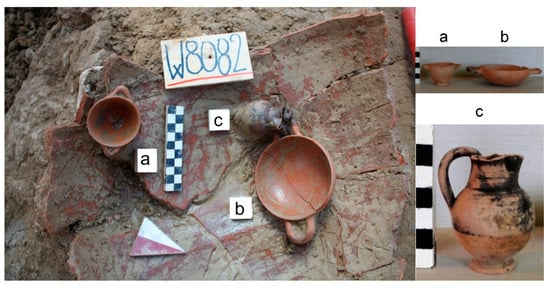 Figure 1. Grave inventory of W8082: (a) skyphos; (b) two-handled cup; (c) trefoil jug.
Figure 1. Grave inventory of W8082: (a) skyphos; (b) two-handled cup; (c) trefoil jug.
2.2. Poseidonia’s and Elea’s 5th-Century BC Amphorae Production through Himera’s perspective
Exceptions being made for the earliest mid-8th to late-6th-century BC Pithecusanian amphorae of types A-B derived from Phoenician-Levantine prototypes [2,3] and based on the archaeological evidence currently available, Greek colonies located in the southern Tyrrhenian coastal region commence to produce transport amphorae not earlier than the late 6th or early 5th century BC. In-depth studies of stratified fragments from the Austrian excavations conducted at Elea, supported by systematic archaeometric research, have allowed for the reconstruction of a reliable, typo-chronological sequence of the 5th-century BC rim shapes of Poseidonia and Elea itself (for all typological references, in the following see Gassner [1]; Gassner and Trapichler [10]; Gassner et al. [11]; for the fabrics, see www.facem.at). Furthermore, the analysis of materials yielded by recent investigations at Piazza Nicola Amore has given evidence for the circulation of 5th-century BC amphorae produced at Poseidonia and Elea in the area of the Gulf of Naples and the existence of a local series [12] (for the fabrics, see www.facem.at).
At present, the earliest Campanian western Greek amphorae of Sourisseau’s form 2 (Figure 2a) have been fabricated at Poseidonia and date to the late 6th century BC. The repertoire of the first or second third of the 5th-century BC is characterised by Gassner’s rim shapes 3–4 (Figure 2b,c) of thickened profile with a ridge at their bottom. Derived from rim type 4, in the course of the second half of the 5th century BC appears Gassner’s shape 7 (Figure 2d) distinguished by slightly everted rims with internally concave profile, underlined by a ridge and combined with bulbous necks [11].
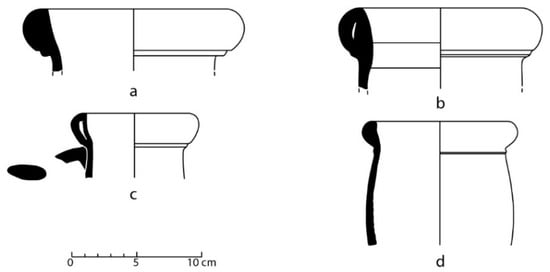
Figure 2.
Typology of western Greek amphorae produced at Poseidonia (after Gassner [1]): (a) Sourisseau form 2; (b) Gassner rim 3; (c) Gassner rim 4; (d) Gassner rim 7. Panels a and b from Gassner and Scopetta [12] (Figures 1 and 2, catalogue 2.11); c and d from Gassner [1] (Figure 10b,c).
At Elea, amphorae production does not start earlier than the second quarter of the 5th century BC, following, however, the typological evolution outlined above for the series of Poseidonia [11].
By consequence, the 5th-century BC amphorae productions of this coastal, southern Tyrrhenian area, refer very clearly to a common morphological koiné.
Within the scope of provenance studies applied to the c. 560 western Greek amphorae unearthed in the necropolis of Himera, ceramic samples have been chipped from almost all of the vessels. By using binocular microscopy and digital photos of freshly broken surfaces (for this method, see http://facem.at/project/about.php#photography), items have been compared with reference samples of archaeological fabrics which have been already attributed [13]. This procedure has led to the identification of a large selection of transport vessels (N 97), presumably imported from Poseidonia, and a very small group of six items, hypothetically originating from Elea (previously, see Bechtold [14]). Representative samples of both archaeological sub-fabrics and types (Table 1) from both assemblages have been selected for petrographic analysis (see Section 4.1). In the following, we will discuss the results of this combined, archaeological-archaeometric study of 16 fragmentary western Greek amphorae attributed to Poseidonia (12 items) and Elea (4 items); one additional sample found at Jerba (Tunisia) was analysed in order to confirm the distribution of the class also in the Carthage’s sphere of influence [14,15].
The amphorae selected for petrography (Table 1) document Poseidonia’s complete 5th-century BC typological repertoire, which will be outlined briefly in the following. The chronologies conferred upon the amphorae are primarily based on morphological considerations and comparisons, combined with the dating of associated grave inventories, if present.
About 30 items out of the whole group from Poseidonia (N 97) refer to the earliest morphological stage of this class, classified as Sourisseau’s forms 2–3/Gassner’s rim shape 3 and dating in between the very late 6th and the first third of the 5th century BC. The presumably earliest items show an almost globular body (Figure 3b), while the bulk of this group is characterised by heart-shaped bodies (Figure 3e) and shallow, cylindrical pegs close to Gassner’s variant 1a. The majority of necks are cylindrical (Figure 3a,b), whereas others present short, truncated cones. Unfortunately, only three amphorae of this group are provided by grave inventories, which suggest a burial of the respective ceramic assemblage within the first quarter of the 5th century BC (Table 1).
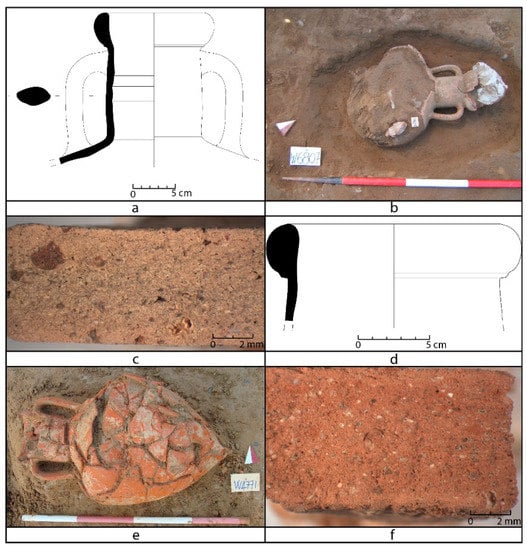
Figure 3.
Poseidonian amphorae from Himera of Gassner rims 3–4: (a–c) W6807; (d–f) W4771. Microphotos of fabrics at ×8 magnification.
Around 30 amphorae can be referred to Gassner’s rim shape 4. The vessels of this group present more or less bulbous necks, rather ovoid-shaped bodies and cylindrical pegs close to Gassner’s variant 1b or type 3 (Figure 4a–c). Clearly incurving handles seem to be typical at least for some of the later items of this series, as is also suggested by a parallel from Lipari [16] (Figure 8, catalogue 27).
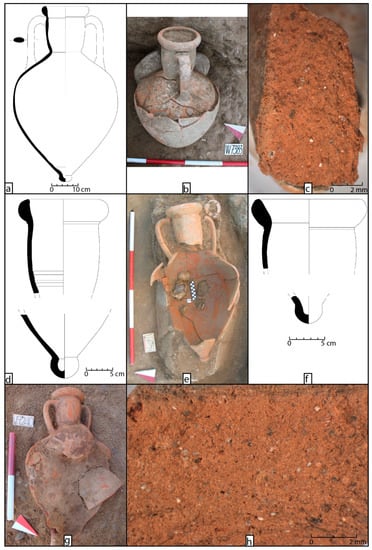
Figure 4.
Poseidonian amphorae from Himera of Gassner rims 4 and 7: (a–c) W7383; (d,e) W7253; (f–h) W9240. Microphotos of fabrics at ×8 magnification.
By contrast to the large Poseidonian assemblage dating to the first and second third of the 5th century BC, Himera’s necropolis have yielded only six amphorae presumably produced at Elea (Figure 5). W382 (Figure 5d–f) seems to represent a typical expression of the morphological evolution of the second third of the 5th-century BC series.
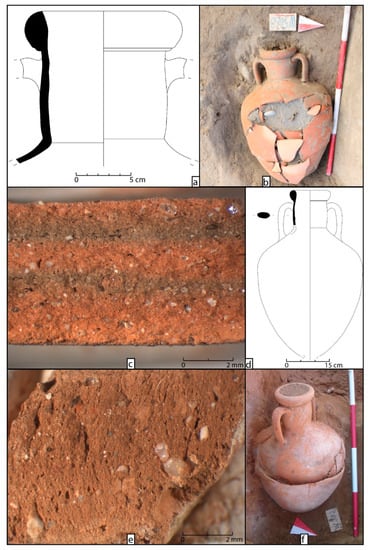
Figure 5.
Elean amphora from Himera of Gassner rims 3–4: (a–c) W5660; (d–f) W382. Microphotos of fabric at ×8 magnification.
Finally, at least nine amphorae can be attributed to Gassner’s late Classical rim shape 7 (Figure 4f–h) dating to the last two decades of life of the Greek colony. The excavation photo of W9240 (Figure 4g) shows an elongated, ovoid-shaped body, tapering towards a rather massive knob-peg of rounded profile of Gassner’s type 3.
2.3. Comparison Materials
2.3.1. Non-Amphoric Samples from Poseidonia
Four samples (Table 2) collected in the area of Poseidonia, representative of local products, were selected for comparison. They are represented by coarse-grained production indicators (M239/1, M226/1) and common ware (M231/3, M231/2).

Table 2.
Reference samples of Poseidonia productions collected in Poseidonia (with production indicators), Elea, and Pithekoussai. When available, petrographic types according to R. Sauer were also reported along with on-line FACEM reference.
Sample M239/1 is a waster, found in the town of Poseidonia, ascribed to a batch of deformed fictile fingers, of possible votive function, welded in a block of concotto (clay hardened by firing), likely a kiln floor or a collapsed kiln vault [17]. Based on the discovery context it is possible to date the object to the first decades of the 3rd century BC. This was found in a dump relevant to an ergasterion located in the northern part of the southern urban sanctuary, used for the production of ceramics and figurines for those who frequented the sacred area [17].
Sample M226/1 is a wedge-shaped spacer found on the laying surface of the 14/68 tomb from the Licinella, a Lucanian funerary area located south of the ancient city. It is a peculiar type of spacer used to support large vessels, architectural elements or decorative slabs and appliques during firing [18]; a chronology between the end of the 5th and the beginning of the 3rd century BC is conceivable. The item was found along with other production indicators in a limited area of the burial ground, giving evidence of the existence of an artisan workshop aimed at the production of objects used in funerary circles [17,19].
Sample M231/2 is a ribbon handle of a kitchen ware (4th–3rd century BC) while M231/3 is a rim of a storage amphora (5th–4th century BC). They were collected among the sporadic materials in the area of the Laghetto necropolis, located to the north-east, outside the city walls. These finds are unusual as grave goods of this burial ground and could be the trace of rituals undertaken outside the burials.
2.3.2. Amphorae Found in Elea and Pithekoussai
Because of the rural nature of the plain of Paestum we can suppose that wine and oil were produced there and then exported in amphorae. However, at the current state of research we do not possess a detailed study of the local amphorae-production. The best overview is given by M. Cipriani and A. Pontrandolfo [20], but, as mentioned by the authors themselves, this list does not distinguish imports from local products. Of importance are also the four amphorae found in the sanctuary of Hera (Foce del Sele) in Poseidonia [21] and an amphora of form Sourisseau 4 from the necropolis of Santa Venera ([22] and Figure 37 therein). A first archaeometric overview on pottery production in Paestum was given by A. De Bonis [23].
The identification of the local production of Poseidonia/Paestum thus relies on a series of analyses conducted by R. Sauer in the 1990s on amphorae found as imports at Elea/Velia, which allowed us to define the characteristics of this production by their comparison to local clay resources collected in the territory of Paestum [24]. Most of the samples stem from the mudbrick-houses of the first half of the 5th century BC, situated under the so-called Insula II, built in the Augustan period [1] (pp. 113–119, and Table 7 therein). Among these materials, imports from the neighbouring town of Poseidonia/Paestum are frequent [1] (p. 133, and Figure 62 therein), so that we have a reliable quantity of finds. To the production of Paestum belong the FACEM fabrics PAE-A-1, PAE-A-2, PAE-A-3, and PAE-A-4. Samples for PAE-A-1 were taken from the material of the Scarico Gosetti from Ischia, previously published by N. Di Sandro [25].
Generally, from a macroscopic point of view, the fabrics of amphorae produced at Poseidonia are orange to brown and display a clearly visible residue of carbonate as well as quartz and mica. The samples selected for this contribution (Table 2 and Figure A4) range from amphorae of the form Sourisseau 3 and 4 (M 37/26, M37/28, M10/22, M10/4, 5th century BC; M6/26, 5th–4th century BC) to amphorae of the form MGS IV (M10/5, late 4th and early 3rd century BC) [26]. They continue to be used at least until the beginning of the 2nd century BC (details will be provided in the volume in preparation by Gassner et al. [27]).
3. Materials and Methods
Petrographic analysis was performed on seventeen samples of amphorae (Table 1), sixteen of which discovered in the archaeological area of Himera and one at Jerba (Figure A2). Additional samples from the Campanian area (Figure A2) were also investigated for comparison (Table 2). These include four non-amphoric samples from Poseidonia represented by production indicators (M239/1, M226/1) and common ware (M231/3, M231/2), four samples of amphorae (M6/26, M10/4, M10/5, M10/22) collected in Elea and ascribed to Poseidonia, along with two amphorae (M37/26, M37/28) found in Pithekoussai (the modern Island of Ischia) also ascribed to Poseidonia.
Polarised light microscopy (PLM) was carried out in order to investigate the petrographic composition and microstructural features of the ceramic samples. Thin section observation was performed with an OPTIKA V-600 POL (OPTO-LAB Instruments, Concordia sulla Secchia, Italy) microscope coupled with a ZEISS AXIOCAM 105 COLOR and ZEN 2.3 Lite software (Oberkochen, Germany) for acquiring the pictures. A total of nine specimens of amphorae discovered at Himera (8) and Jerba (1) were selected because of their homogeneous petrographic and microstructural features for modal, particle-size, and shape analyses, performed on collages of micrographs (40× magnification).
Modal analysis quantitatively assessed the percentage of matrix, voids, and non-plastic inclusions via a point-counting procedure [28] performed with the 3.2.1 version of the Leica Q Win software (Wetzlar, Germany) and a minimum of 2000 points per sample. This measurement can be considered representative as the maximum uncertainty is around 2.8% already at 1500 points [28,29]. The inclusions amount of other samples was estimated via comparative charts [30].
Grain size and shape measurements were performed using the 1.52a version of the public domain Java image processing software ImageJ (National Institutes of Health, Bethesda, MD) and statistically processed with the 3.4.4 version of the R Development Team software (R Foundation for Statistical Computing, Vienna, Austria) to obtain distribution density histograms [31,32]. The batch feature in Photoshop (CC 2015 version; Adobe Inc., San Jose, CA, USA) was used to automatically apply thresholds and make binary images. Thresholding was carefully inspected before the measurement was performed. Grain size distribution (GSD) was measured considering the minimum Feret (mF) value in millimetres for calculating the Krumbein phi scale (ϕmF = −log2 (mF)). This parameter in sedimentology is based on the effective diameter determining the grain size of a class obtained by sieving [33]. The circularity value (C = 4π (A/P2), where A = area, P = perimeter) was considered as a shape descriptor [34,35].
4. Results
4.1. Petrographic Features of Amphorae Discovered at Himera and Jerba
The thin section analyses of the amphorae discovered at Himera and Jerba (sample M149/54) showed that most samples are characterised by similar petrographic and microstructural characteristics. The matrix is frequently birefringent or shows a weak optical activity; an inactive matrix was observed in five samples (M179/141, M179/144, M179/154, M179/210, M149/54).
The common features of all amphorae are the presence of fine particles of quartz and muscovite and abundant siliciclastic coarse grains represented by quartzose inclusions (quartz, sandstone, and occasional chert) (Figure 6a–l) with a modal percentage, estimated on representative samples, approximately ranging from 15% to 22% (Table 3). Minor alkali feldspar (approx. 0.7–3.5%) and plagioclase (less than 0.3%) also occur. Altered (partly sericitised) feldspar minerals occur in several samples (Figure 6c) and more frequently in M179/133, M179/135, and M179/147; deformed feldspar crystals were occasionally observed (Figure 6j). In most samples sporadic clinopyroxene crystals are visible (Table 3; Figure 6d,f,g), whereas low amounts of volcanic lithics were observed in sample M179/135. Metamorphic lithics (schist, gneiss) also occur (0.3–1.4%) in several samples (Figure 6h,i) and show slightly higher amounts in samples M179/133 and M179/135 (Table 3).
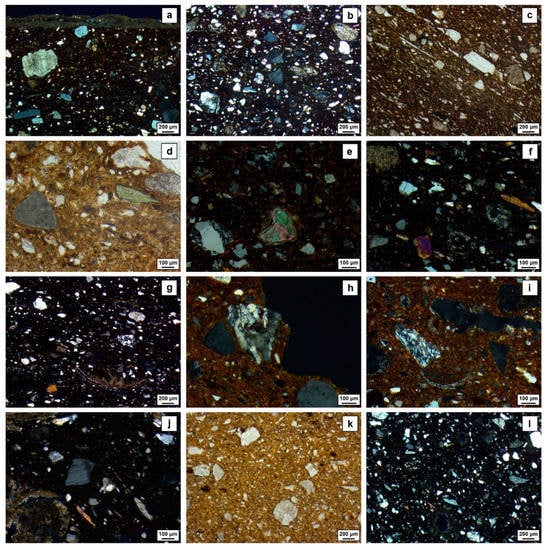
Figure 6.
Photomicrographs showing the petrographic features of the amphorae collected at Himera: (a) M179/127. Quartzose inclusions (crossed polars); (b) M179/144. Siliciclastic inclusions and decomposed carbonate (crossed polars); (c) M179/133. Elongated and oriented pores and altered feldspars (parallel polars); (d) M179/132. Clinopyroxene and carbonate fragment (parallel polars); (e) M179/241. Sparry calcite (crossed polars); (f) M179/136. Clinopyroxene, decomposed carbonate and ‘calcite ghosts’ (crossed polars); (g) M179/129. Carbonate bioclasts and clinopyroxene (crossed polars); (h) M179/135. Metamorphic lithic (crossed polars). (i) M179/137. Carbonate bioclasts and metamorphic lithic (crossed polars); (j) M179/154. Decomposed carbonate and deformed feldspar crystal (crossed polars); (k) M179/281. Sparse inclusions (parallel polars); (l) M149/54. Serial distribution of grains and calcite ‘reaction rims’ (crossed polars).

Table 3.
Petrographic and textural features of the amphorae collected at Himera and Jerba. GSD = grain size distribution, PSD = pore size distribution. Quantitative modal data, MGS (maximum grain size based on minimum Feret) and circularity of representative samples were also reported. Abbreviations of minerals (Whitney and Evans [39]) and rock fragments (Ingersoll and Suczek [40]; Dickinson [41]): Q = quartz and polycrystalline quartz (inc. chert), Afs = alkali feldspar, Pl = plagioclase, Cpx = clinopyroxene, Cb = carbonate fragments (inc. primary and decomposed calcite, pseudomorphic ‘calcite ghosts’, and carbonate bioclasts), Ms = muscovite, Amp = amphibole, Lm = metamorphic lithics, Lv = volcanic lithics. xxxx = very abundant, xxx = abundant, xx = frequent, x = sporadic, r = rare.
Thirteen samples (M179/127, M179/129, M179/132, M179/134, M179/136, M179/137, M179/141 M179/144, M179/146, M179/154, M179/210, M179/241, M149/54), among those mentioned above, differ in the presence of carbonate grains varying in amount from 2.8% to 6.4%, except for M149/54, where a lower amount (0.3%) was detected. Carbonate inclusions, which also occur in the form of bioclasts (Figure 6f), are represented either by micritic (Figure 6d) or minor sparry calcite (Figure 6g). Carbonate clasts are frequently decomposed (Figure 6j) or appear as pseudomorphic ‘calcite ghosts’ (Figure 6b) and reaction rims (Figure 6l) left from decomposition [36].
Microstructural features, quantitatively assessed on representative samples, show that amphorae are generally characterised by a moderately sorted and negatively skewed GSD density curves with a tail extending to large grain sizes (Figure 7), often showing a small bulge indicating a weak bimodality with coarse particles mainly included in the range of fine sands (2–3 ϕmF; Figure 7). The maximum grain size (MGS) varies from 266 to 668 μm (Table 3). The highest MGS value was measured in the sample M179/281, which is also characterised by sparse coarse particles (Figure 6k). Sample M149/54 shows a more continuous (serial) distribution of the grain sizes (Figure 6l) and the lowest MGS (266 μm; Table 3). In all samples, grains are frequently represented by angular crystal and rock fragments and minor sub-rounded inclusions, frequently composed of decomposed carbonate. Circularity (see Figure A5) was used as the shape factor and shows mean values ranging from 0.37 to 0.59, indicating an intermediate circularity. The minimum values (0.37) were attested in samples M179/146 and M179/210 and the maximum in M179/127 (Table 3). Porosity is mostly characterised by elongated mesopores (width 50–500 μm [37,38]) generally randomly or partially oriented; oriented voids were observed in M179/133, M179/147, and M149/54 (Table 3). Pore percentage is quite low and ranges from 0.9% (M149/54) to 4.6% (M179/210) (Table 3).
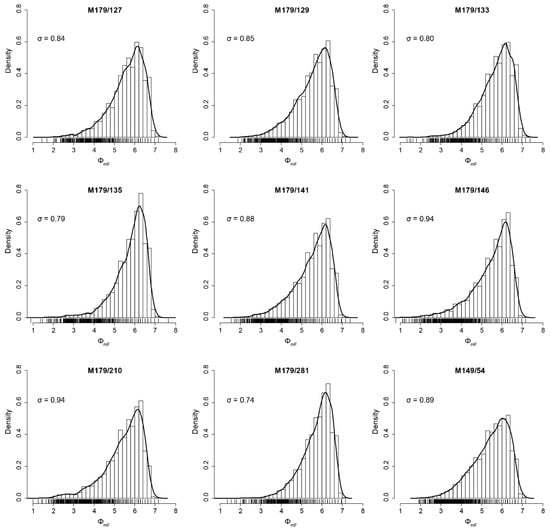
Figure 7.
GSD density histograms of the inclusions minimum Feret’s diameter converted to the phi scale (ϕmF) for the representative amphorae discovered at Himera and Jerba (M149/54). Standard deviation (σ) is also reported.
4.2. Petrographic Features of the Reference Samples
4.2.1. Samples from Poseidonia
Production indicators from Poseidonia (M239/1, M226/1) are characterised by an inactive matrix and prevalent coarse inclusions (Figure 8a–d) represented by angular quartzose grains (quartz, sandstone), occasionally bearing a metamorphic undulose extinction (Figure 8c), and subordinate alkali feldspar. Sporadic plagioclase and muscovite were detected in M226/1. Volcanic inclusions composed of volcanic lithics (only in M239/1; Figure 8a) and clinopyroxene (Figure 8a,c) occur in low amounts. Sub-rounded carbonate clasts often represented by microfossils or decomposed lumps are common (Figure 8b,d).
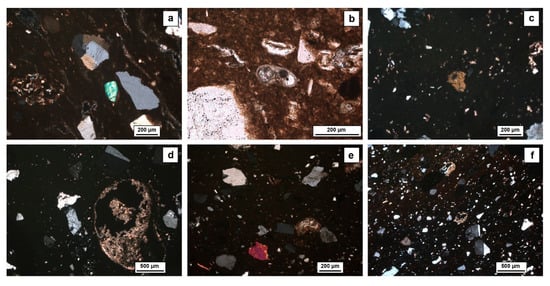
Figure 8.
Photomicrographs showing the petrographic features of the production indicators (M239/1, M226/1) and common ware (M231/3, M231/2) from Poseidonia: (a) M239/1. Quartzose inclusions, volcanic lithic and clinopyroxene (crossed polars); (b) M239/1. Carbonate bioclasts (parallel polars); (c) M226/1. Clinopyroxene (crossed polars); (d) M226/1. Decomposed carbonate fragment (crossed polars); (e) M231/2. Carbonate bioclasts and clinopyroxene (crossed polars); (f) M231/3. Siliciclastic inclusions and decomposed carbonate.
Common ware samples (M231/2, M231/3) basically show the same petrographic features of production indicators, except for a slightly more active matrix (Figure 8e,f). They mostly contain coarse inclusions of siliciclastic origin composed of quartzose grains with minor amounts of alkali feldspar and plagioclase. Clinopyroxene was detected in low amounts in M231/2 (Figure 8e). Decomposed carbonate bioclasts (Figure 8e) and lumps (Figure 8e,f) are frequent.
In all samples, porosity is characterised by occasional isolated voids left from carbonate decomposition, except for M239/1 where elongated mesopores are frequent (Figure 8a).
4.2.2. Amphorae Found in Pithekoussai and Elea
Samples of amphorae (M37/26, M37/28) found in Pithekoussai show an active matrix with a low porosity and inclusions approximately ranging from 20–25%. Grains are moderately sorted and show a bimodal distribution. Fine inclusions are composed of quartz and muscovite. Coarse grains are mostly siliciclastic (quartz, sandstone) (Figure 9a–d). Metamorphic lithics (Figure 9d) are also present. Carbonate particles are frequent and are represented by sparry calcite (Figure 9a) and occasionally decomposed fragments (Figure 9d); bioclasts are also common (Figure 9b,c). Alkali feldspar and plagioclase (occasionally deformed) were detected in moderate amounts. Clinopyroxene (Figure 9a) is present in M37/26 along with the rare biotite and garnet (Figure 9b).
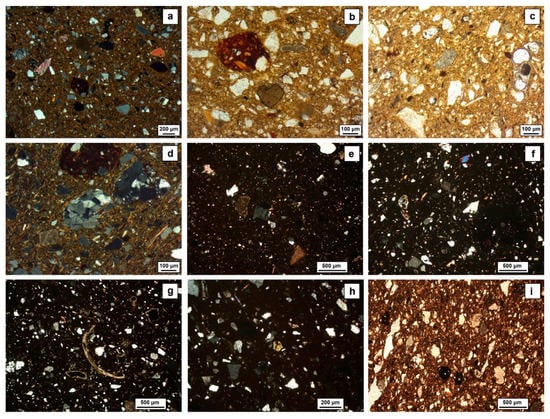
Figure 9.
Photomicrographs showing the petrographic features of the amphorae found in Pithekoussai (M37/26, M37/28) and Elea (M6/26, M10/4, M10/5, M10/22): (a) M37/26. Siliciclastic grains, sparry calcite and clinopyroxene (crossed polars); (b) M37/26. Garnet and argillaceous fragment (parallel polars); (c) M37/28. Carbonate bioclast (parallel polars); (d) M37/28. Metamorphic lithic and carbonate fragment (crossed polars); (e) M10/5. Siliciclastic inclusions and carbonate clasts (crossed polars); (f) M6/26. Siliciclastic inclusions, clinopyroxene and decomposed calcite (crossed polars); (g) M10/4. Partly decomposed bioclasts (crossed polars); (h) M10/4. Quartzose grains and clinopyroxene (crossed polars); (i) M10/22. Carbonate fragments and clinopiroxene (parallel polars).
Amphorae found in Elea (M6/26, M10/4, M10/5, M10/22) are characterised by very similar petrographic features. The matrix is inactive in samples M6/26, M10/4, M10/5 and active in M10/22. Porosity is low. The inclusions are moderately sorted and bimodally distributed and are represented by quartz and muscovite in the fine fraction. Coarse grains are mainly siliciclastic and are composed of quartz, sandstone, and feldspars (alkali feldspar and plagioclase). Carbonate fragments are also common and are often represented by decomposed grains (Figure 9e–g,i) and bioclasts (M10/4, M10/22; Figure 9g). Occasional clinopyroxene was detected in M6/26, M10/4, and M10/22 (Figure 9f,h,i).
5. Discussion and Conclusions
5.1. Provenance and Technology
The petrographic analysis of the amphorae discovered at Himera and Jerba (sample M149/54) of supposed Campanian provenance provided an important diagnostic basis for supporting the hypothesis of this connection. Most of the analysed samples (M179/127, M179/129, M179/132, M179/134, M179/136, M179/137, M179/141 M179/144, M179/146, M179/154, M179/210, M179/241, M149/54) show a typical association of siliciclastic-carbonate inclusions often accompanied by clinopyroxene of very likely volcanic origin. This petrographic composition is also typical of coarse wares produced in the territory of Poseidonia/Paestum [23] and is fully compatible with the geological features of the area, where sources of siliciclastic and carbonate rocks crop out along with minor volcanic layers [42,43].
The locally specific petrographic features mentioned above are also evident in the production indicators and common ware from Poseidonia used for comparison. Actually, local reference materials of common ware are very similar from a petrographic point of view to these coarse-grained production indicators and, in turn, are also homogeneous to each other from a chemical point of view [23]. Based on fabric analysis, M. Trapichler [44] grouped these common wares in the existing FACEM fabric PAE-C-2 (ribbon handle, M231/2), established for Poseidonia’s coarse ware [10], and in the new fabric PAE-REG-C-4 (storage amphora, M231/3), which is very similar to or is a variation of PAE-C-2 with a coarser grain size [44].
Other samples analysed for comparison are the amphorae found in Pithekoussai and Elea ascribed to Poseidonia and which testifies the circulation of amphorae from this town within the Campanian area. Samples discovered in Elea are ascribed to the FACEM fabrics PAE-A-2 (M6/26, M10/5) and PAE-A-3 (M10/4, M10/22), which are very similar to each other [10]. According to R. Sauer, samples discovered in Elea can be grouped in his petrographic type RVA003 (sample M6/26) or are very close to it. This type is marked by the presence of quartzose grains (quartz and minor sandstone), occasionally of metamorphic origin, carbonate fragments (pseudomorphic and bioclasts), alkali feldspar (occasionally sericitised), sporadic plagioclase, and muscovite. Volcanic particles such as clinopyroxene occur in minor amounts along with rare garnet. Samples M37/26, M37/28 found in Pithekoussai belong to the petrographic type RVA003a, which is analogous to the former and only differs in its slightly lower carbonate content. These samples well reflect the typical mineralogical association of the area of Poseidonia [23] and share common features with other local samples of common ware and bricks. It is worth noting the occurrence of volcanic inclusions frequently observed in the investigated samples from Poseidonia. They are derived from the pyroclastic fall deposits related to Neapolitan volcanoes (Phlegraean Fields and Somma-Vesuvius), in particular, from pyroclastics ascribed to eruptions of Mt. Somma older than that of AD 79 [43,45]. A distinctive marker of the activity of this volcano is garnet [46,47,48], which was found in one sample collected in Pithekoussai (M37/26) and is common in samples of the Sauer’s petrographic types RVA003/RVA003a from Poseidonia.
Bringing up the amphorae found at Himera again, we noticed four samples (M179/133, M179/135, M179/147, M179/281) which are siliciclastic-rich and do not show any occurrence of carbonate. These samples display a composition very similar to that of samples of the Sauer’s petrographic type RVA001, typical of local transport amphorae from Elea [49]. Amphorae of this type are characterised by abundant siliciclastic inclusions mainly represented by quartz, sandstone, alkali feldspar and minor plagioclase. Feldspars often show a typical sericitisation as in the analysed samples M179/133, M179/135, where metamorphic lithics also occur in slightly higher amounts with respect to other amphorae. Sporadic clinopyroxene (M179/135, M179/281) and volcanic lithics (M179/135) can also be found [49,50]. These petrographic features are distinctive of Elea [24,49] and point to a possible provenance of samples M179/133, M179/135, M179/147, M179/281 from this settlement.
The analytical considerations made so far provide a good possibility for distinguishing the pottery of Poseidonia from that of Elea, especially considering carbonate grains that are virtually absent in the latter (Table 4).

Table 4.
Inferred provenance of amphorae discovered at Himera and Jerba with the main petrographic components. Colour (Munsell Soil Colour Chart) of samples is also reported. N/A = not available.
On the other hand, a provenance of the investigated amphorae from the area of Himera should be excluded because of both archaeological reasons and fabric analysis [51], which did not find any similarity with local coarse ware from Himera. Archaeometric argumentations on pottery and raw materials from Himera analysed so far [52,53] do not seem to point out an affinity with the selection of analysed amphorae. Additional analytical techniques in progress on this selection (unpublished data) and on Himerian amphorae (see Bechtold et al. [54] for preliminary results) will provide further evidence to distinguish local productions from imports.
Microstructural analysis provided some technological clues. In particular, the negatively skewed grain size distribution along with the weak bimodality occasionally shown in the density plots (Figure 7) pointed out the addition of temper [31,34]. The moderate sorting of particles, the shape, and their relatively small size (mostly fine sand with MGS not higher than c. 670 μm) indicate a good selection of the temper used for the mixture. Actually, tempering can improve the shock resistance of ceramics. An experimental study by De Bonis et al. [55] demonstrated that discontinuities formed at the interfaces between temper grains and clay matrix help dissipate mechanical energy, thus providing a good toughness to the ceramic body, which can tolerate shocks better with no damage incurred. Furthermore, a temper amount around 20%, similar to that observed for the analysed amphorae, associated to the quite low porosity would favour the waterproof characteristics, and is a fair compromise between water resistance and toughness, especially for transport amphorae stressed for their specific use [55].
5.2. Archaeological and Historical Remarks
The identification, at Himera, of an exceptional high number of nearly hundred 5th-century BC transport vessels imported from Poseidonia confirms the close relationship between the two cities already inferred earlier [56]: among the c. 460 last quarter of the 6th–5th century BC western Greek amphorae recorded from the Himerian necropolis, the selection from Poseidonia totals around 22%, representing the second class in frequency after a huge group of southern Calabrian vessels. Amphorae from Poseidonia reach Himera regularly from the very late 6th-early 5th century to the end of the city in 409 BC, with a possible peak of influx during the middle decades of that century.
Recent provenance studies of amphorae from several southern-central Mediterranean sites have already given evidence for the circulation of apparently smaller quantities of 5th-century BC Poseidonian vessels in Tunisia (Carthage, Ghizène/Jerba, for one analysed sample M149/54), see Table 1), in the Sicilian Channel at Pantelleria, in the hinterland of Solunto at Pizzo Cannita [14], and possibly also at Lipari [1] (pp. 200–201).
Within the scope of the on-going project (see acknowledgement), the fabric analysis of further assemblages of western Greek amphorae yielded by the Grotta Vanella dump and the Mango sanctuary at Segesta and by the intensive excavations and field surveys at Entella has allowed for the identification of a handful of 5th-century BC amphorae from Poseidonia also at these western Sicilian inland-sites.
From a geographical point of view, the massive presence of the class under discussion at Himera fits nicely in the distribution pattern outlined above. Any differences which occur between our colony and the other sites are predominantly confined to quantitative aspects. However, even if on the basis of an admittedly very small number of analysed samples (16–19 items for each site), at least at the three Punic sites of Ghizène/Jerba [15], Carthage [57], and Cossyra [58] 5th-century BC, Poseidonian amphorae consistently represent the third group in frequency, after the Ionian-Adriatic and southern Calabrian series.
The new, quantified ceramic evidence from Himera justify, in any case, the reconstruction of a veritable trading axis, connecting the southern Campanian area to the westernmost Greek apoikia of Sicily’s northern coast. However, the phenomenon of the massive documentation, in the Dorian-Chalcidian colony, of important quantities of storages vessels imported from Poseidonia, appears to be more complex and has to be embedded in the wider frame of the city’s commercial and also its probable social interaction with the southern Etruria [59] (p. 220), as well as with the Campanian area [8,56] from the second half of the 7th century BC onwards. Concerning the latter, Cuma stands out as the most probable candidate, not only for the provenance of several architectural terracottas, but also for the transfer, to Himera, of technological experiences related to the construction of roofs and even of artisans during the late Archaic and early Classical period [8]. A special relationship probably with Poseidonia has been suspected on occasion of the discovery of 11 silver coins from Poseidonia in a mid-5th century BC grave unearthed in Himera’s necropolis (see Section 2.1).
Unfortunately, almost nothing is known from the written sources about Poseidonia’s 6th - 5th century BC history [60] (p. 11). However, its agricultural vocation – derived from its geographic location in the fertile Sele River plain—has been sufficiently outlined. An important archaeological indicator is the interruption of the city’s coinage (with a begin around 540/30 BC) from c. 490–475 BC [61]. This iatus is usually related to political changes and the probable introduction of a democratic regime. Contemporaneously, in 476 BC and as a result of the repression of its citizens, at Himera the despot Terone from Akragas repopulates the city by the abduction of Dorian people, perhaps in part from Poseidonia [9]. In the following, during the third quarter of the 5th century BC, Poseidonia becomes the most productive mint in Magna Graecia [61]. This evidence harmonises perfectly with the massive presence, in Himera’s necropolis, of amphorae from Poseidonia dating to the second and third quarter of the 5th century, which underlines impressively the cities ‘Campanian connection’ during the decades following the battle of 480 BC and the re-population implemented by Terone. Finally, the flux of the class at Himera might have decreased towards the late 5th century BC, again in parallel with the reduction of Poseidonia’s coinage and historically related to the increasing Lucanian pressure on the city [61].
By contrast, 5th-century BC transport vessels from Elea are extremely rare at Himera and currently absent at other central Mediterranean consumption sites [57], confirming Velia’s supposed, scarce agricultural surplus production during the Classical period. The economic force of the Phocaean city is usually explained by its commercial activity based on trade with not-locally generated commodities. As a hypothesis, the supra-regional distribution of Poseidonia’s 5th-century BC amphorae has been attributed to Elea [1], also in view of the absence, at Poseidonia, of a suitable harbour [60] (pp. 34–35). Notwithstanding and by contrast to Poseidonia, Elea’s 5th-century BC coinage appears to be very weak and characterised by a low circulation of proper money—as well as of the amphorae—outside the city’s territory [61], which seems to contradict an intensive involvement in ‘international’ trade.
Hence, the issue of the commercial vectors responsible of the arrival at Himera of both amphorae from Poseidonia and architectural terracottas, presumably from Cuma, is still unclear. Unfortunately, no 5th-century BC ship-wreck carrying southern Campanian ceramic artefacts has thus far been found along the Tyrrhenian-Sicilian route and the question remains unanswered. It seems likely, however, that at least until the battle of Himera in 480 BC a special role at this regard has been invested by the allied colony of Rhegion [62].
The combined, archaeological-archaeometric research outlined in this paper highlights the extraordinary importance of provenance studies of non-local pottery from ancient consumption sites. In the present case of western Greek amphorae and with special regard to the late Archaic-early Classical rim shape 3 of Gassner’s typology, produced by several Greek apoikiai (see Section 1), only the analysis of their ceramic fabrics and petrographic composition may lead to a correct geographic attribution.
Concerning Himera and based on the identification of the largest assemblage of 5th-century BC transport amphorae from Poseidonia ever documented outside the production region, we can now confidently sustain a special relationship between these two colonies. The phenomenon blends in with Himera’s particularly close commercial and probably also social interaction with the coastal, southern-central Tyrrhenian region from its foundation period onwards. More in-depth studies in the material culture of both production and consumption sites need to be done in order to formulate hypotheses regarding possible traffic agents.
Author Contributions
Conceptualization, B.B., A.D.B.; sampling, B.B., S.V., V.G., A.S., M.L.R.; methodology, A.D.B.; formal analysis, A.D.B.; investigation, A.D.B. and R.S.; writing—original draft preparation, A.D.B., B.B.; writing—review and editing, A.D.B., B.B., S.V., V.G., R.S., A.S., M.L.R., T.N.; B.B. is responsible for Section 1, Section 2.2., and Section 5.2.; A.D.B. for Section 3, Section 4, and Section 5.1.; S.V. for Section 2.1.; A.S. and M.L.R. for Section 2.3.1.; V.G. for Section 2.3.2.; funding acquisition, B.B. and A.D.B. All authors have read and agreed to the published version of the manuscript.
Funding
Open Access Funding by the Austrian Science Fund (FWF): P 30030-G25 (B.B.) and M 1918-G25 (A.D.B) grant numbers.
Acknowledgments
B.B. acknowledges the support of the Austrian Science Fund (FWF): P 30030-G25 for the project “Trade of western Greek amphorae (6th–5th century BC) from the perspective of Himera (western Sicily): a contribution to the identification of production centres, typological repertoires and distribution patterns”. Furthermore, she thanks Ch. Michelini and A. Corretti (both Scuola Normale Superiore di Pisa) for the opportunity to sample an ample assemblage of western Greek amphorae from Entella and its hinterland. She is grateful to M. de Cesare, P. Cipolla (both Università di Palermo) and M. Quartaro (Pisa) for the possibility to sample smaller selections of western Greek amphorae yielded by the Grotta Vanella dump and the Mango sanctuary at Segesta. The issue of this research will be published in a joined contribution. Finally, she thanks F. Ferlito for his contribution to the ceramic fabric analysis and R. Lampl (Universität Wien) for the composition of Figure 2, Figure 3, Figure 4, Figure 5 and Figure A1. A.D.B. acknowledges support from the Austrian Science Fund (FWF): M 1918-G25 for the project “Ceramic production in the plain of Paestum”. All the authors thank the staff of the Parco Archeologico di Paestum and, in particular, the Director G. Zuchtriegel for providing the necessary authorization for sampling, the former Director M. Cipriani for technical support to the project. We also thank B. Huber for the drawings of Figure A4 and S. Gallagher for the English revision of the text. Finally, the authors wish to thank the Editors of Minerals, the Guest Editor of the Special Issue (G. Balassone) and the three anonymous reviewers for their suggestions that significantly improved this manuscript.
Conflicts of Interest
The authors declare no conflict of interest.
Appendix A

Figure A1.
Typology of western Greek amphorae (after Gassner [1] and Sourisseau [3]): (a) Form 1α (SK232); (b) Form 2 (W1881); (c) Form 3 (L90); (d) Form 5 (W380); (e) Gassner rim 6 (W1076). All amphorae here presented are from the necropolis of Himera and currently under investigation by B. Bechtold.
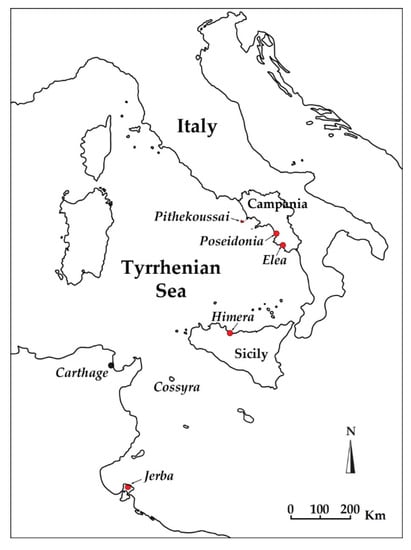
Figure A2.
Map showing the discovery sites of the investigated samples.
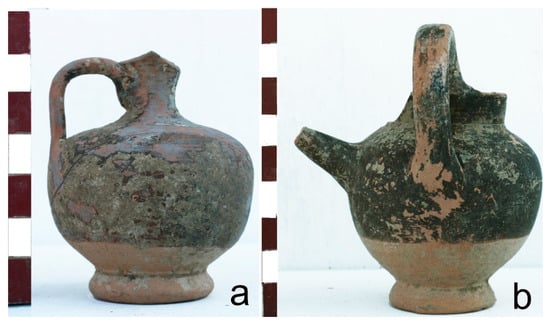
Figure A3.
Grave inventory of W7253: (a) globular lekythos; (b) guttus.
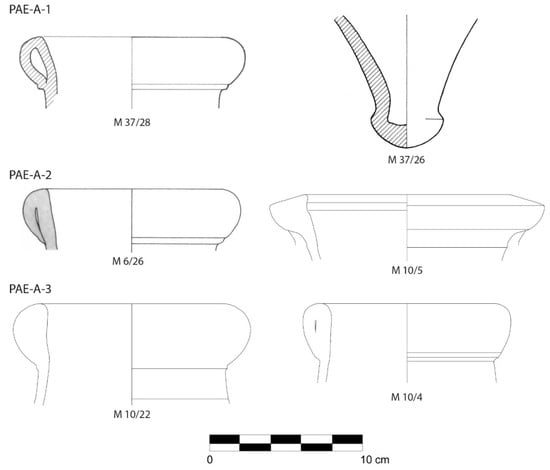
Figure A4.
Selection of amphorae found in Pithekoussai (M37/28, rim fragment Sourisseau form 3; M37/26 fragment of toe Sourisseau form 4) and Elea (M6/26 rim fragment Sourisseau form 3/4; M10/5 rim fragment MGS IV; M10/22 rim fragment Sourisseau form 3/4; M10/4 rim fragment Sourisseau form 3/4). FACEM fabrics (PAE-A-1, -2, -3) were also reported.
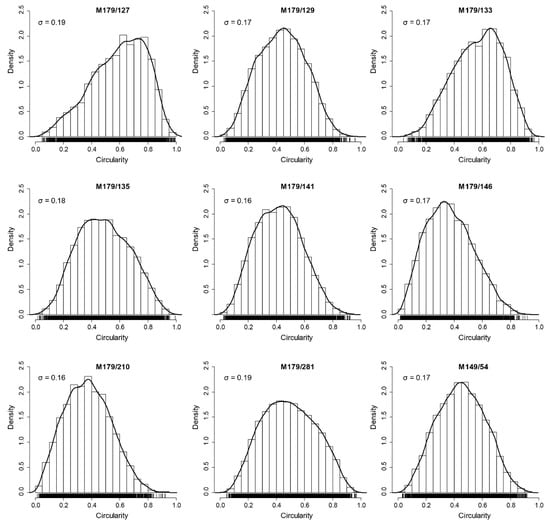
Figure A5.
Circularity density histograms of the inclusions for the representative amphorae discovered at Himera and Jerba (M149/54). Standard deviation (σ) is also reported.
References
- Gassner, V. Materielle Kultur und kulturelle Identität in Elea in spätarchaisch-frühklassischer Zeit. Untersuchungen zur Gefäß- und Baukeramik aus der Unterstadt (Grabungen 1987–1994); Archäologische Forschungen 8. Velia-Studien 2; Verlag der Österreichischen Akademie der Wissenschaften: Wien, Austria, 2003. [Google Scholar]
- Gassner, V. Le anfore greco-occidentali: Riconsiderando la loro evoluzione e l’identificazione dei centri di produzioni. In Contacts et acculturations en Méditerranée occidentale. Hommages à Michel Bats (Hyères 2011); Poure, R., Ed.; Maison Méditerranéenne des Sciences de l’Homme: Aix-en-Provence, France, 2015; Études Massaliètes 12; pp. 345–356. [Google Scholar]
- Sourisseau, J.-C. La diffusion des vins grecs d’Occident du VIIIe au IVe s. av. J.-C., sources écrites et documents archéologiques. In La vigna di Dioniso: Vite, vino e culti in Magna Grecia, Atti del quarantanovesimo Convegno di Studi sulla Magna Grecia, Taranto, Italy, 24–28 September, 2009; ISAMAG: Taranto, Italy, 2011; Volume 49, pp. 145–252. [Google Scholar]
- Sacchetti, F. Les amphores grecques dans le Nord de l’Italie. Échanges comerciaux entre les apennins et les Alpes aux époques archaïque et Classique; Bibliothèque d’Archéologie Méditerranéenne et Africaine 10; Édition Errance: Aix-en-Provence, France, 2012. [Google Scholar]
- Sacchetti, F.; Sourisseau, J.-C. Sur les importation d’amphores en contextes hallstattiens: Regards croisés depuis le Midi de la Gaule et le bassin nord-adriatique. In L’âge du Fer en Aquitaine et sur ses marges. Mobilité des hommes, diffusion des idées circulations des biens dans l’espace européen du Fer, Actes du XXXVe colloque de l’AFEAF, Bordeaux, France, 2–5 June 2011; Colin, A., Verdin, F., Eds.; Aquitania: Bordeaux, France, 2013; Aquitania Supplément 30; pp. 643–664. [Google Scholar]
- Savelli, S. Anfore greco-occidentali in Magna-Grecia: Un aggiornamento sul tipo ‘corinzio B arcaico’ e ‘ionico-massaliota’. In Obeloi. Contatti, scambi e valori nel Mediterraneo antico. Studi offerti a Nicola Parise; Camia, F., Privitera, S., Eds.; Pandemos: Paestum (SA), Italy, 2009; Tekmeria 11; pp. 105–129. [Google Scholar]
- Vassallo, S. Bibliografia ragionata sulle necropoli di Himera. In Notiziario Archeologico della Soprintendenza di Palermo; Sezione Archeologica della Soprintendenza per i Beni culturali e ambientali di Palermo: Palermo, Italy, 2018; n. 30; Available online: http://www.regione.sicilia.it/beniculturali/dirbenicult/notiziarioarcheologicopalermo/30_S_Vassallo_Bibliografia_ragionata_sulle.pdf (accessed on 1 March 2020).
- Vassallo, S. Importazione e diffusione di oggetti dalla Magna Grecia a Himera. In «Kithion Lydios». Studi di storia e archeologia con Giovanna Greco; Cicala, L., Ferrara, B., Eds.; Naus: Pozzuoli (NA), Italy, 2017; Quaderni del Centro Studi Magna Grecia 22; pp. 533–543. [Google Scholar]
- Boehringer, C.; Brousseau, L.; Vassallo, S. Monete in tomba: Due tesoretti di argento dalla necropoli occidentale di Himera. Ann. Ist. It. Num. 2011, 57, 9–38. [Google Scholar]
- Gassner, V.; Trapichler, M. Fabrics of Paestum. In FACEM, Version 06/06/2011. Available online: http://www.facem.at/project-papers.php (accessed on 1 March 2020).
- Gassner, V.; Trapichler, M.; Sauer, R. Pottery Production at Velia: Archaeometric Analyses and the Typological Development of Glazed Ware, Coarse Wares and Tranport Amphorae. In Archaeometry. Comparing Experiences; Greco, G., Cicala, L., Eds.; Naus Editoria: Napoli, Italy, 2014; Quaderni del Centro Studi Magna Grecia 19; pp. 191–269. [Google Scholar]
- Gassner, V.; Scopetta, E. Western Greek Amphorae from the Excavations at piazza Nicola Amore, Naples. In Archaeometry. Comparing experiences; Greco, G., Cicala, L., Eds.; Naus Editoria: Napoli, Italy, 2014; Quaderni del Centro Studi Magna Grecia 19; pp. 111–125. [Google Scholar]
- Gassner, V.; Trapichler, M. What Is a Fabric? In FACEM, Version 06/06/2011. Available online: http://www.facem.at/project-papers.php (accessed on 1 March 2020).
- Bechtold, B. La distribuzione della produzione anforica di Poseidonia/Paestum (V-I sec. a.C.) nell’area di influenza punica (Sicilia, Tunisia, Malta): Una revisione dei dati editi e prospettive di ricerca. In FACEM, Version 06/12/2018. Available online: http://www.facem.at/project-papers.php (accessed on 1 March 2020).
- Bechtold, B. Ghizène (Jerba) and Mediterranean trade from the 5th to the 3rd century BCE: The evidence of the Greek transport amphorae. Carthage Stud. 2019, 10, 89–142. [Google Scholar]
- Cavalier, M. Les amphores du VIè au IV siècle dans les fouilles de Lipari. Cahiers des amphores archaïques et classiques 1; Cahiers du centre Jean Bérard IX; Centre Jean Bérard: Naples, Italy, 1985. [Google Scholar]
- Rizzo, M.L. Aree e quartieri artigianali in Magna Grecia; Pandemos: Paestum (Salerno), Italy, 2019; Ergasteria 9. [Google Scholar]
- Cracolici, V. I sostegni di fornace dal kerameikòs di Metaponto, BACT 3; Edipuglia: Bari, Italy, 2003. [Google Scholar]
- Rizzo, M.L. Uno scarto di fornace dalla bottega del Gruppo Barbarizzante. In Atti del II Convegno Internazionale di Studi Dialoghi sull’Archeologia della Magna Grecia e del Mediterraneo, Paestum (SA), Italy, 28–30 June 2017; pp. 699–708. [Google Scholar]
- Cipriani, M.; Pontrandolfo, A. Paestum.Scavi, Ricerche, Restauro. I - Le mura. Il tratto da Porta Sirena alla Postierla 47; Pandemos: Paestum (SA), Italy, 2010; Tekmeria 8.1; pp. 279–283. [Google Scholar]
- Visco, S. Le anfore da trasporto. In Il santuario di Hera alla foce del Sele. Indagini e studi 1987-2006, Atti e memorie della società Magna Grecia IV; de La Genière, J., Greco, G., Eds.; Società Magna Grecia: Roma, Italy, 2010; pp. 509–510. [Google Scholar]
- Scafuro, M. Le Necropoli di Poseidonia-Paestum. Santa Venera (Scavo 1976); Pandemos: Paestum (Salerno), Italy, 2019; Ergasteria 8.1. [Google Scholar]
- De Bonis, A. Ceramic Production in the Plain of the Sele River. The Preliminary Results of the Archaeometric Analyses. In FACEM, Version 06/12/2018. Available online: http://www.facem.at/project-papers.php (accessed on 1 March 2020).
- Gassner, V.; Greco, G.; Sauer, R. Analisi archeometriche a Velia: Ceramiche arcaiche e laterizi. In Elea – Velia, le nuove ricerche, Atti del Convegno di studi, 14 December 2001; Greco, G., Ed.; Naus: Pozzuoli (NA), Italy, 2003; Quaderni del Centro Studi Magna Grecia 1; pp. 199–205. [Google Scholar]
- Di Sandro, N. Le anfore arcaiche dallo scarico Gosetti, Pithecusa; Centre Jean Bérard: Naples, Italy, 1986; Cahiers du Centre Jean Bérard 12. [Google Scholar]
- Van Der Mersch, C. Vins et amphores de grande Grèce et de Sicilie IVe -IIIe s. avant J.C.; Centre Jean Bérard: Naples, Italy, 1994; Études Centre Jean Bérard 1; pp. 73–76. [Google Scholar]
- Gassner, V.; Sokolicek, A.; Trapichler, M. Von Hyele zu Velia. Die Stadtmauern im urbanistischen Kontext. Die österreichischen Forschungen in der West- und Unterstadt (1974, 1993 und 1997–2001). Velia-Studien 4. (in preparation)
- Rispoli, C.; Graziano, S.F.; Di Benedetto, C.; De Bonis, A.; Guarino, V.; Esposito, R.; Morra, V.; Cappelletti, P. New Insights of Historical Mortars Beyond Pompei: The Example of Villa del Pezzolo, Sorrento Peninsula. Minerals 2019, 9, 575. [Google Scholar] [CrossRef]
- Howarth, R.J. Improved estimators of uncertainty in proportions, point-counting, and pass-fail test results. Am. J. Sci. 1998, 298, 594–607. [Google Scholar] [CrossRef]
- Terry, R.D.; Chilingar, G.V. Summary of “Concerning some additional aids in studying sedimentary formations” by MS Shvetsov. J. Sediment. Petrol. 1955, 25, 229–234. [Google Scholar] [CrossRef]
- Grifa, C.; De Bonis, A.; Langella, A.; Mercurio, M.; Soricelli, G.; Morra, V. A Late Roman ceramic production from Pompeii. J. Archaeol. Sci. 2013, 40, 810–826. [Google Scholar] [CrossRef]
- Grifa, C.; De Bonis, A.; Guarino, V.; Petrone, C.M.; Germinario, C.; Mercurio, M.; Soricelli, G.; Langella, A.; Morra, V. Thin walled pottery from Alife (Northern Campania, Italy ). Period. Mineral. 2015, 84, 65–90. [Google Scholar] [CrossRef]
- Dal Sasso, G.; Maritan, L.; Salvatori, S.; Mazzoli, C.; Artioli, G. Discriminating pottery production by image analysis: A case study of Mesolithic and Neolithic pottery from Al Khiday (Khartoum, Sudan). J. Archaeol. Sci. 2014, 46, 125–143. [Google Scholar] [CrossRef]
- Germinario, C.; Cultrone, G.; Cavassa, L.; De Bonis, A.; Izzo, F.; Langella, A.; Mercurio, M.; Morra, V.; Munzi, P.; Grifa, C. Local production and imitations of Late Roman pottery from a well in the Roman necropolis of Cuma in Naples, Italy. Geoarchaeology 2019, 34, 62–79. [Google Scholar] [CrossRef]
- Grifa, C.; Germinario, C.; De Bonis, A.; Mercurio, M.; Izzo, F.; Pepe, F.; Bareschino, P.; Cucciniello, C.; Monetti, V.; Morra, V.; et al. Traditional brick productions in Madagascar: From raw material processing to firing technology. Appl. Clay Sci. 2017, 150, 252–266. [Google Scholar] [CrossRef]
- Fabbri, B.; Gualtieri, S.; Shoval, S. The presence of calcite in archeological ceramics. J. Eur. Ceram. Soc. 2014, 34, 1899–1911. [Google Scholar] [CrossRef]
- Whitbread, I.K. Greek Transport Amphorae: A Petrological and Archaeological Study; British School at Athens: Athens, Greece, 1995; Fitch Laboratory Occasional Paper 4. [Google Scholar]
- Quinn, S.P. Ceramic Petrography: The Interpretation of Archaeological Pottery & Related Artefacts in Thin Section; Archaeopress: Oxford, UK, 2013. [Google Scholar]
- Whitney, D.L.; Evans, B.W. Abbreviations for names of rock-forming minerals. Am. Mineral. 2010, 95, 185–187. [Google Scholar] [CrossRef]
- Ingersoll, R.V.; Suczek, C.A. Petrology and provenance of Neogene sand from Nicobar and Bengal fans, DSDP sites 211 and 218. J. Sediment. Res. 1979, 49, 1217–1228. [Google Scholar]
- Dickinson, W.R. Interpreting provenance relations from detrital modes of sandstones. In Provenance of Arenites; Zuffa, G.G., Ed.; Reidel Publishing Company: Dordrecht, The Netherlands, 1985; Nato ASI Series; v. 148; pp. 333–361. [Google Scholar]
- Amato, V.; Aucelli, P.P.C.; Argenio, B.; Da Prato, S.; Luciana, F.; Pappone, G.; Paola, P.; Rosskopf, C.M.; Russo Ermolli, E. Holocene environmental evolution of the costal sector in front of the Poseidonia-Paestum archaeological area (Sele plain, southern Italy). Rend. Lincei 2012, 23, 45–59. [Google Scholar] [CrossRef]
- Aucelli, P.P.C.; Amato, V.; Budillon, F.; Senatore, M.R.; Amodio, S.; D’Amico, C.; Da Prato, S.; Ferraro, L.; Pappone, G.; Russo Ermolli, E. Evolution of the Sele River coastal plain (southern Italy) during the Late Quaternary by inland and offshore stratigraphical analyses. Rend. Lincei 2012, 23, 81–102. [Google Scholar] [CrossRef]
- Trapichler, M. Pottery Production in the Southern Sector of the Bay of Salerno: The Fabrics of Paestum. In FACEM, Version 06/12/2018. Available online: http://www.facem.at/project-papers.php (accessed on 1 March 2020).
- Insinga, D.; Molisso, F.; Lubritto, C.; Sacchi, M.; Passariello, I.; Morra, V. The proximal marine record of Somma-Vesuvius volcanic activity in the Naples and Salerno bays, Eastern Tyrrhenian Sea, during the last 3 kyrs. J. Volcanol. Geotherm. Res. 2008, 177, 170–186. [Google Scholar] [CrossRef]
- Morra, V.; De Bonis, A.; Grifa, C.; Langella, A.; Cavassa, L.; Piovesan, R. Minero-petrographic study of cooking ware and pompeian red ware (Rosso Pompeiano) from Cuma (Southern Italy). Archaeometry 2013, 55, 852–879. [Google Scholar] [CrossRef]
- De Bonis, A.; Febbraro, S.; Germinario, C.; Giampaola, D.; Grifa, C.; Guarino, V.; Langella, A.; Morra, V. Distinctive Volcanic Material for the Production of Campana A Ware: The Workshop Area of Neapolis at the Duomo Metro Station in Naples, Italy. Geoarchaeology 2016, 31, 437–466. [Google Scholar] [CrossRef]
- Guarino, V.; De Bonis, A.; Faga, I.; Giampaola, D.; Grifa, C.; Langella, A.; Liuzza, V.; Pierobon Benoit, R.; Romano, P.; Morra, V. Production and circulation of thin walled pottery from the Roman port of Neapolis, Campania (Italy). Period. Mineral. 2016, 85, 95–114. [Google Scholar] [CrossRef]
- Gassner, V.; Sauer, R. Transport Amphorae from Velia. In FACEM, Version 06/06/2015. Available online: http://www.facem.at/project-papers.php (accessed on 1 March 2020).
- Sauer, R. Pottery Production at Velia: Ceramic Raw Materials and Archaeometric Analyses. In FACEM, Version 06/06/2015. Available online: http://www.facem.at/project-papers.php (accessed on 1 March 2020).
- Trapichler, M. Fabrics of Himera. In FACEM, Version 06/06/2011. Available online: http://www.facem.at/project-papers.php (accessed on 1 March 2020).
- Alaimo, R.; Giarrusso, R.; Iliopoulos, I.; Montana, G. Coppe tipo Iato K480: Indagini archeometriche finalizzate alla individuazione del centro di produzione. In Atti del I Congresso Nazionale di Archeometria, Verona, Italy, 2–4 December 1999; Martini, M., D’Amico, C., Fassani, L., Garagnani, G.L., Improta, S., Milazzo, M., Petrucci, F., Sabbioni, C., Eds.; Pàtron editore: Bologna, Italy, 2000; pp. 413–425. [Google Scholar]
- Montana, G.; Iliopoulos, I.; Tardo, V.; Greco, C. Petrographic and Geochemical Characterization of Archaic-Hellenistic Tableware Production at Solunto, Sicily. Geoarchaeology 2009, 24, 86–110. [Google Scholar] [CrossRef]
- Bechtold, B.; Vassallo, S.; Ferlito, F. La produzione delle anfore greco-occidentali di Himera: Uno studio sulla loro identificazione. In Notiziario Archeologico della Soprintendenza di Palermo; Sezione Archeologica della Soprintendenza per i Beni culturali e ambientali di Palermo: Palermo, Italy, 2019; n. 51. [Google Scholar]
- De Bonis, A.; Cultrone, G.; Grifa, C.; Langella, A.; Morra, V. Clays from the Bay of Naples (Italy): New insight on ancient and traditional ceramics. J. Eur. Ceram. Soc. 2014, 34, 3229–3244. [Google Scholar] [CrossRef]
- Vassallo, S. Oggetti in movimento in età arcaica e classica ad Himera, porto sicuro per uomini, merci, idee. In Sanctuaries and the Power of Consumption. Networking and the Formation of Elites in the Archaic Western Mediterranean World, Proceedings of the International Conference in Innsbruck, 20–23 March 2012; Kistler, E., Öhlinger, B., Mohr, M., Hoernes, M., Eds.; Harrassowitz Verlag: Wiesbaden, Germany, 2015; pp. 153–167. [Google Scholar]
- Bechtold, B. Distribution Patterns of Western Greek and Punic Sardinian Amphorae in the Carthaginian Sphere of Influence (6th–3rd century BCE). Carthage Stud. 2013, 7, 43–119. [Google Scholar]
- Bechtold, B. Le anfore da trasporto da Cossyra: Un’analisi diacronica (VIII sec. a.C. - VI sec. d.C. attraverso lo studio del materiale della ricognizione. In Cossyra II. Cossyra. Ricognizione topografica. Storia di un paesaggio mediterraneo; Schäfer, T., Schmidt, K., Osanna, M., Eds.; Verlag Marie Leidorf: Rahden/Westfahlen, Germany, 2013; Tübinger Archäologische Forschungen 11; pp. 409–517. [Google Scholar]
- Allegro, N. Himera V. L’abitato. Isolato II. I blocchi 1-4 della zona 1; Università di Palermo: Palermo, Italy, 2008. [Google Scholar]
- Pedley, J.G. Paestum. Greeks and Romans in Southern Italy; Thames and Hudson: London, UK, 1990. [Google Scholar]
- Brousseau, L. Les productions monétaires des ateliers grecs de Grand Grèce du VIe au IVe siècle av. J.-C. Essai de quantification comparée. In Quantifying Monetary Supplies in Greco-Roman times; Callataÿ, F., Ed.; Edipuglia: Bari, Italy, 2011; Pragmateiai 19; pp. 163–179. [Google Scholar]
- De Sensi Sestito, G. La Calabria in età arcaica e classica: Storia, economia, società. In Storia della Calabria; Cingari, G., Ed.; Gangemi Editore: Roma-Reggio Calabria, Italy, 1987; pp. 227–304. [Google Scholar]
© 2020 by the authors. Licensee MDPI, Basel, Switzerland. This article is an open access article distributed under the terms and conditions of the Creative Commons Attribution (CC BY) license (http://creativecommons.org/licenses/by/4.0/).